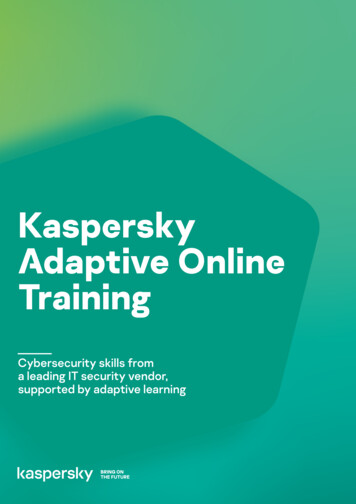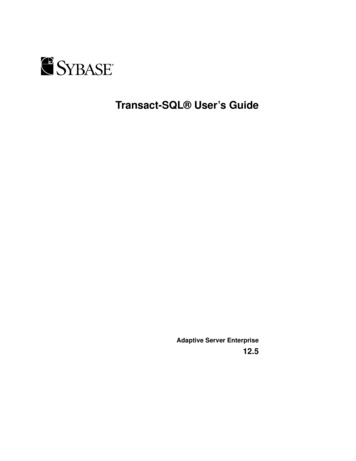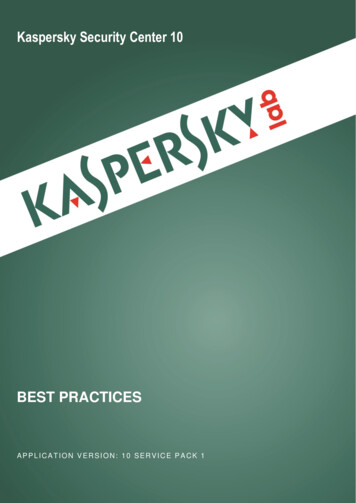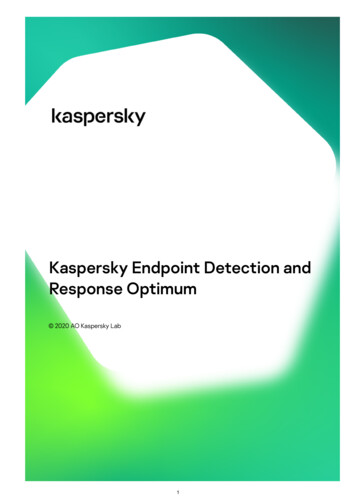
Transcription
KasperskyAdaptive OnlineTrainingCybersecurity skills froma leading IT security vendor,supported by adaptive learning
KAOT: KasperskyAdaptive Online TrainingMore than 80% of all cyber-incidents are caused by human error*, and enterprises lose millions recoveringfrom these incidents. Employees are the main gateway into the organization for attackers – but properlytrained, cyber-aware staff who practice cyber-hygiene can also become a very effective first line ofdefense. There are various training programs on the market, but a very traditional approach often fails toachieve the desired motivation and behavioral changes to be effective.Why is traditional awareness trainingoften ineffective?Many awareness solutions help companies to adhere to compliance standards forsecurity awareness, but in fact they don’t change employees’ behavior and don’tensure long-lasting use of acquired skills. Among the main reasons why training failwith their mission are: Doesn’t ensure the progress of each individualA ‘one-size-fits-none’ approach, whether online or classroom-based, fall short.The more employees in the program, the more difficult it is to create a curriculumthat takes into account their individual abilities and characteristics. Training takes too much timeIf an employee has already mastered a skill, there’s no option to skip those lessons,making the training long and tedious to get through.“Ignorance morefrequently begetsconfidence thandoes knowledge.”Charles Darwin,The Descent of Man Employees aren’t motivated to learnPeople don’t always recognize their knowledge needs, and think they know somethingwhen they don’t. This results in unconscious incompetence where employees aren’tmotivated to learn something because they think they already have those skills andlearning them is a waste of time, even when it’s not. Content isn’t engagingTraining is often generalized rather than personalized and interactive, so it’s notengaging and struggles to achieve skills retention. Videos, games, and online coursestyle training have their place, but they don’t restructure individual learning pathsaccording to personal knowledge levels and contribute to true mastery of thematerials.Why should enterprises considerKaspersky when looking for a securityawareness training provider?Kaspersky has expanded its portfolio with a product specifically tailored forenterprises – Kaspersky Adaptive Online Training (KAOT). KAOT is the resultof collaboration between Kaspersky and Area9 Lyceum, a leader in adaptivelearning systems.KAOT training is unique solution combining content based on Kaspersky’s 20 years’experience in cybersecurity and an advanced learning & development methodology.Grounded in innovative adaptive learning methodology, the cognitive-driven approachcontributes to a personalized learning experience that takes into account the abilitiesand needs of each and every learner. The individual learning path fosters retention andautomatic skills use that changes employee attitudes and habits sustainably, protectingenterprise cybersecurity from human error.* C ybSafe analysis, ICO1
What distinguishes KAOT fromother offerings? Kaspersky Cybersecurity skillset: based on our vast experience in cybersecurity,we have identified a set of skills that every employee should possess in order tooperate IT safely at work. This skillset forms the content of the training. Adaptive learning system: by adjusting a learner’s current level of knowledge andcreating a customized learning path for each person, the adaptive learning algorithmmakes sure that the learner masters the skills until they become automatic.“Each problem that Isolved became a rule,which served afterwardsto solve other problems.”Rene Descartes,Discourse on MethodWhat makes the KAOT solutionso effective? One-on-one personal tutor approachOne of the main components of this efficiency is a personal tutor-like approach that’sachieved as a result of using key elements of learning science: problem-based learning,keeping the learner at just the right difficulty of study throughout, using differentapproaches to the same topic and constantly assessing the learner’s progress. Saves employees’ timeThe training suggests a personalized approach for each employee, depending ontheir current level of skills, confidence in these skills/ knowledge and their ability toabsorb information, so they can learn without wasting time on what they have alreadymastered1. Boosts internal motivationAdaptive learning can identify areas in which people are unconsciously incompetent –i.e. they think they know something, but in fact they don’t! By identifying how familiara learner is with a topic, they are provided with explanations and help only when theyneed it. Eliminating tiresome repetition helps improve internal motivation. Immersive learning processThe platform uses formative assessment teaching by asking questions that ensurethat the learner has learnt everything and that the knowledge it not only acquired,but anchored. No overtraining or excessively long and tiring learning modules.Reinforcement and knowledge refreshment of those topics that an employee foundmost difficult contribute to making use of the skills automatic.1 T raining time cut by up to 50% compared totraditional online or classroom training2
How does adaptive learning work?An innovative cognitive approach lies at the heart of the adaptive learning. It’sgrounded in research on human factors and adaptive algorithms and contributes toa personalized, tutor-like teaching experience at scale that take into considerationthe abilities and needs of each learner. It allows learners to move forward accordingto their competences, using different approaches to the same topic when neededand constantly assessing whether the learner is progressing. By building an individuallearning path, training fosters greater competency in cybersecurity essentials,contributing to a safe corporate cyber environment.The KAOT platform uses algorithms to evaluate the learner constantly and adjustthe learning path accordingly. It moves steadily from unconscious incompetence toconscious competence, which gives learners more awareness and greater confidencein what they know, resulting in better application of cybersafe behavior in theireveryday work, leading to better business nceConsciouscompetenceAutomaticity is the ability to dothings without occupying the mind,allowing it to become an automaticresponse pattern or habitAUTOMATICITYSkills refreshmentKAOT adapts to the learner, presenting content only when necessary; studentsreceive follow-up in areas in which they struggle, filling skill gaps and building greatercompetency quickly and effectively. At a high level of competency, certain knowledgebecomes second nature, allowing actions to become automatic and habitual. This levelof knowledge mastery is known as “automaticity.” KAOT builds automatic cybersafebehavior that is constantly reinforced by “refresh” activities when a learner might be atrisk of forgetting the content. The result is an optimized path to learner proficiency.Training efficiency ensured by entConsciousUnconsciousCompetentIncompetent3
How is the training structured?The platform’s content is based on a competency model consisting of practical andessential cybersecurity skills that all employees should have. Without these skills,whether through ignorance or negligence, employees can damage your business. Passwords Email Security Web browsing Social networks andmessengers PC security Mobile devices GDPREvery lesson begins with a question, and based on the user’s understanding of thetopic, the platform then either follows up with a theoretical lesson or moves to anothertopic (if the answers were correct). The platform will also ask to identify the level ofcertainty about each statement to offer the learner a relevant scenario according totheir actual unconscious competency level.As of June 2020, KAOTwill be available in thefollowing languages:English, German, Spanish,Arabic, French, Italian,Russian.Each lesson consists ofQuestions where it’s important to ratethe level of confidence in the answer.Be honest, it’s not an exam!Short text explanations when a learnerneeds itThe administrator needs to choose which modules to assign to each group of users.Once registered, each employee can run the lessons in their preferred order. The contentof every lesson is built according to the user’s progress and confidence, ensuring thatthey learn only those skills that they don’t know and skip those they do (and already use).Every lesson must be refreshed within a certain time period, automatically depicted in theuser’s interface.4
The picture below shows the learning paths of three different learners who took thesame course. At the end, each learner achieved 100% proficiency, but they learnt atdifferent speeds and in a different manner. Every circle on the scheme is a topic - thebigger the circle the longer it took for the learner to master it. People learn at differentrates, taking into account many factors, including their ability to absorb information andexisting knowledge levels, but they all ultimately mastered the skill.Individual learning paths based on anemployee’s answers and their level ofconfidenceLearner 1Learner 2Learner 2Takes an almost linear paththrough the course as mostof the answers were correctand he/she was confidentabout them.Requires much moresupport and explanationsas 52% of the initialanswers were correct.47% correct. Has as muchto learn as Learner 2,especially struggled withone learning objective.100% proficientat 8m 25s100% proficientat 19m 39s100% proficientat 33m 40sIs there a mechanism to preventcheating?The training program is 100% personalized – KAOT checks the unconscious competencylevel of each employee and builds the program accordingly, so employees receivedifferent questions according to their level of knowledge, making cheating impossible.How do you track results?Extensive statistics allow you to follow up employee progression – performancesummary, reports and diagrams for groups and individuals. Admin can identify highperformers as well as those who need additional coaching. Reports on user progress,progress of classes, assignment details with indepth analysis of employee competenceand metacognition as well as an ‘at risk’ diagram showing employees’ unconsciousincompetence analytics all help to track results.Comprehensive analytics The way for educators tomanage students – all learning inpersonalized ways. Handle assignments and/orlearning paths. Advanced analytics. Early warning technology tohighlight at-risk students.5
What are the training outcomes? Uncovers and fixes unconscious incompetence, providing motivation for learning andensuring sustainable cybersafe behavior Eliminates boredom and frustration through a personalized approach to each learnerwhich boosts engagement and involvement in cybersecurity Ensures automatic, habitual use of skills, as a result of: Training materials adapted to individual learners’ characteristics How the content is presented, taking into account the specifics of adult learning Constant assessments that make learners constantly solve problems and answerquestions that help them to better absorb information Ongoing “refreshment” – returning to those topics and issues that causeddifficulties early on. Cuts training time by 50% thanks to the adaptive learning methodology, so less timeis spent on training and more time applying it on the job.Technical features: Supports Single Sign On (SSO) via OpenID Connect AD synchronization is available through integration with ADFS Can be integrated with LMS via the SCORM or LTI e-learning formats (SCORM 1.2and LTI 1.0, LTI 1.1 and LTI 1.1.1)6
2020 AO KASPERSKY LAB. ALL RIGHTS RESERVED. REGISTERED TRADEMARKS AND SERVICE MARKS ARE THE PROPERTY OF THEIR RESPECTIVE OWNERS. GBD-6382 Q2/2020 V2www.kaspersky.comwww.kaspersky.com/awareness
experience in cybersecurity and an advanced learning & development methodology. Grounded in innovative adaptive learning methodology, the cognitive-driven approach contributes to a personalized learning experience that takes into account the abilities and needs of each and every learner. The individual learning path fosters retention and

![Kaspersky Antivirus 6.0.4.1424. Key File 18 [REPACK]](/img/59/maramon.jpg)




![Kaspersky Password Manager 9.0.1.447 Crack [BETTER]](/img/55/kaspersky-password-manager-901447-crack-better.jpg)




